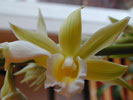|
|
|
|
| Register Yourself at Meyers Conservatory |
To register yourself with the Meyers Conservatory web site, please click the button
below and follow the instructions. You may just make a simple registration with your
email address and a password, but to use the advanced features like the Wish List
you should follow the registration process all the way into the User Information Page
where you can specify plants you are interested in and decide what kind of notifications
you will get.
|
|
|
|
|
| |
Flasks of
Phaius tankervilliae var. bernaysii 'Marcus Tyaeronius' × self |
|
| |
|
|
| |
|
|
Click to Enlarge

Pod Parent Flower |
|
|
|
| |
Culture Notes from Donor: Parent plant: Temperature range I (60-83°F). Grown in a sandy mix in a large pot.
Comments: Parent plant: A fast grower with similar cultural requirements to P. tankervilliae. Native to eastern Australia, though much rarer than its cousin tankervilliae. Very large plant.
For additional origin/habitat information supplied courtesy of
Charles and Margaret Baker, see further below, near the bottom of this page.
|
Temperatures we attempt to use in the lab & greenhouse:
| For Species: |
|
Spring, Summer, Autumn: days average 87°F, nights 69°F; best fit is Warm 90-70°F
(Source:
Baker's Web OSC) |
| For Species: |
|
Winter: days average 82°F, nights 57°F; best fit is Intermediate 83-60°F
(Source:
Baker's Web OSC) |
|
About the name...
| Etymology of |
Phaius |
|
From Greek "phaios", dark. Refers to the dark flower of the first species described.
(Source:
Pridgeon 1992) |
| Etymology of |
tankervilliae |
|
Named for Emma Lady Tankerville, English orchid enthusiast during the 19th century.
(Source:
Mayr & Schmucker 1998) |
| Pronunciation of |
Phaius |
|
FAY-us
(Source:
Pridgeon 1992) |
| Pronunciation of |
tankervilliae |
|
tan-ker-VIL-ee-eye
(Source:
Hawkes 1978) |
|
If you would like to direct someone to this web page, please copy and paste this URL into your email:
http://troymeyers.com/d?014608
| Flask Information |
| Availability: |
We have sold all of the flasks for this item. |
| You should: |
Consider getting individual plants or compots instead of a flask.
You can place a "Notify Flask Recipients" Request, and either we or a flask recipient may contact you when plants are available.
You may also place a "Notify Retries" Request, and if an identical pollination (the same parents) is done again, we'll let you know.
You may reserve a flask, but it's very unlikely you'll get one ...this could only happen if we found a flask that we didn't know we had. |
| Yield Estimate: |
310 plants (based on flask surveys done 04/05/2005 )
|
| Plantlet Sizes: |
From many flasks 4 - 90 mm plants (based on flask surveys done 04/05/2005 through 03/13/2006)
From one most recently surveyed flask 60 - 80 mm (03/13/2006)
|
|
You might also want to:
|
View the seed assay for this item.
View items of the same species.
View items of the same genus.
|
| Ordering Information |
| You are not currently logged in. |
|
You must be a registered user and be logged in to reserve a flask or place a notification request. Please log in:
|
|
| Register Yourself at Meyers Conservatory |
To register yourself with the Meyers Conservatory web site, please click the button
below and follow the instructions. You may just make a simple registration with your
email address and a password, but to use the advanced features like the Wish List
you should follow the registration process all the way into the User Information Page
where you can specify plants you are interested in and decide what kind of notifications
you will get.
|
|
|
|
|
|
|
|
| |
The origin/habitat information below is supplied courtesy of Charles and Margaret Baker
The following information is based on the name of the plant provided by the donor, and assumes that the name is correct. If the plant has been misidentified, then the following information may not be correct.
This text is copyrighted by the Bakers and may not be reproduced without permission.
ORIGIN/HABITAT: Tropical and subtropical climates of Asia, the Pacific
islands, Australia, and Africa. This wide ranging, variable species is
also found at high elevations in nearly temperate weather conditions. It
grows in open, grassy fields, in moist, open deciduous forests, and in
swampy areas of shady, evergreen forests. It has naturalized at higher
elevations in Hawaii and the Caribbean islands.
More about this information and the Bakers...
|
|
|
| |
|
|
|